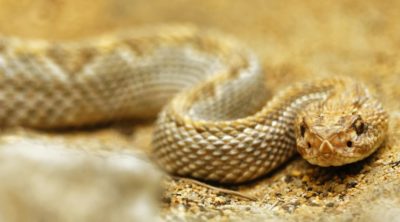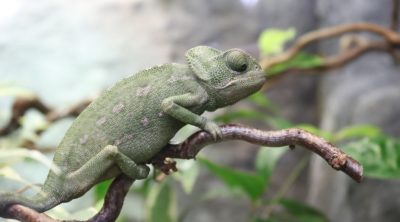
A red-tailed boa is an unusual pet, and if you plan to buy one, do so only after gaining complete information about its proper care and maintenance. Here is a guide on how to take good care of your red-tailed boa.
Red-tailed boas (Boa constrictor constrictor) can be found all over South and Central America, and prefer to live in humid climatic conditions. The snake is brown or gray, and marked with brown or red markings, which are very prominent toward its tail, from where it derives its name. These boa constrictors are very popular in the pet reptile market, and often exported to the United States from Caribbean and South American nations.
Keep in mind that the snake can grow as long as 10 feet, and weigh at least 50 pounds, with a lifespan of 25 years. You must have patience while handling them. Being a powerful reptile, it is not easy to handle a full-grown snake, it can get quite unmanageable for one person. Also remember that they cannot be domesticated as well as a dog or a cat, and can get quite irritable even after being tamed.
A Guide to Red-tailed Boa Care
Buying Your Red-tailed Boa
The snake you buy should have clear and firm skin with no signs of wounds and sagging, clear eyes, healthy scales (not crusty and dried out in any way), a clean vent, and a rapidly flicking tongue. These are the signs of a healthy snake. When you pick up the snake, it should coil itself around your arm tightly, but should relax when it senses there is no danger; this proves it is alert to its surroundings.
Enclosure Requirements
Following are some factors that you need to keep in mind as regards its home environment. You need to keep in mind that the more comfortable its dwelling place, the healthier and more at ease it will feel.
Cage
You can put a baby snake in a standard glass aquarium, but a larger snake will need a much bigger enclosure. Being rather strong, boas can easily escape, so the enclosure you choose must be highly secure. An adult snake will need a cage that is at least 8 feet in length, 3 feet wide, and 3 feet tall. The more the room, the better it is for an adult snake. It is advisable to have one adult snake per enclosure. The cage should be easy to clean.
Substrate
For a young snake, use sheets of paper towels as a substrate, since they are easy to clean. For an adult snake, commercially prepared reptile bark is ideal. Or buy cypress or fir bark substrate. But avoid wood shavings made of pine, cedar, and aspen. These are harmful for the snake’s health, if accidentally consumed, the snake may choke on them, or they may cause impactions, and even skin irritation.
Temperature and Humidity Control
Red-tails prefer a warm, tropical climate. Maintain day temperature between 80 – 90 °F, and at night reduce it to 75 – 85 °F. These snakes like to bask, so provide a basking spot, with the temperature maintained around 95 °F. You can also buy reptile heating pads which are adhesive and can be glued to the underside of the enclosure.
These help increase the temperature, and maintain it at least 15 degrees above the actual enclosure temperature. Heat rocks, or hot rocks are not a good choice to provide extra heat. Snakes cannot make out if the surface is very hot, and are therefore highly prone to thermal burns if heat rocks are used. For extra heat, you can also use incandescent light bulbs which are equipped with a dimmer switch which will help you to regulate the temperature in case it gets too hot.
These snakes prefer humidity, so keep a bowl of water inside the enclosure. It should be stable enough and should not topple over if the snake decides to climb inside for a soak. Clean the bowl regularly, as it may be full of feces.
Hiding Places
It is essential to provide a couple of hiding places, one at the cooler end of the cage, one at the warmer end. Plastic containers with a hole, sturdy cardboard boxes, logs, or reptile caves available at pet stores are good options. They should not be too big, just right enough for the snake to fit in. Hiding makes the snake feel safe. If it feels threatened, it will be stressed out and not feed properly.
Diet
Mice are a staple diet of red-tails. A baby snake can be fed with a small mouse, and an adult snake can be fed larger rodents, including rabbits. As a rule of thumb, whatever animal you feed the snake with should not be larger than the girth of the snake at its widest point. If it’s any bigger, it will result in regurgitation. Always feed pre-killed animals. Feed once a week, or every other week. If you feel your snake is gaining weight (since there is not much activity), reduce the frequency of feedings. Never feed with your hand, your pet may bite you!
Things to Keep in Mind
- Boas, like all other snakes will shed their skin on a regular basis. Juveniles may cast off their skin once a month, but adult snakes will shed once in four months. Bear in mind that shedding can be triggered by stress, which can even be brought out by a change in their enclosures. It is best to avoid handling the snake in such a condition.
- Boas are prone to mites, mouth rot, and scale rot. Take your snake to the vet at the first instance of the disease so immediate action can be taken to prevent further spread of the disease. Mites are a very stubborn pest to get rid of. If you have two snakes in one enclosure, the first step you should do is quarantine them, which will control further infestation. Ask your vet for approved methods of mite control and treatment which should also be safe for the snake.
- Take utmost care while handling your pet. Never attempt to hold their head. Always approach the second half of the body. Do not jerk or make sudden hand movements. Never let children get anywhere close to the reptile. Snakes are highly unpredictable, and even a tamed snake might get irritable and end up biting the handler. Handling the snake on a daily basis will acquaint you with your new pet faster. Pick up the snake confidently. If you are scared, the snake will sense your nervousness, and will get scared too, and might snap. If it is an adult snake, it is advisable to have one more handler around with you.
A red-tailed boa constrictor might seem like an exciting pet to care for, but buy one only if you are mentally prepared to take care of a reptile that can get very big and heavy to handle. Remember that you will always need help to handle a full-grown boa, especially when it is time to take it to a vet for regular checkups. Buy a red-tailed only if you have the time required to care for such an unusual and huge pet, and are ready to fully tend to it with complete dedication.

